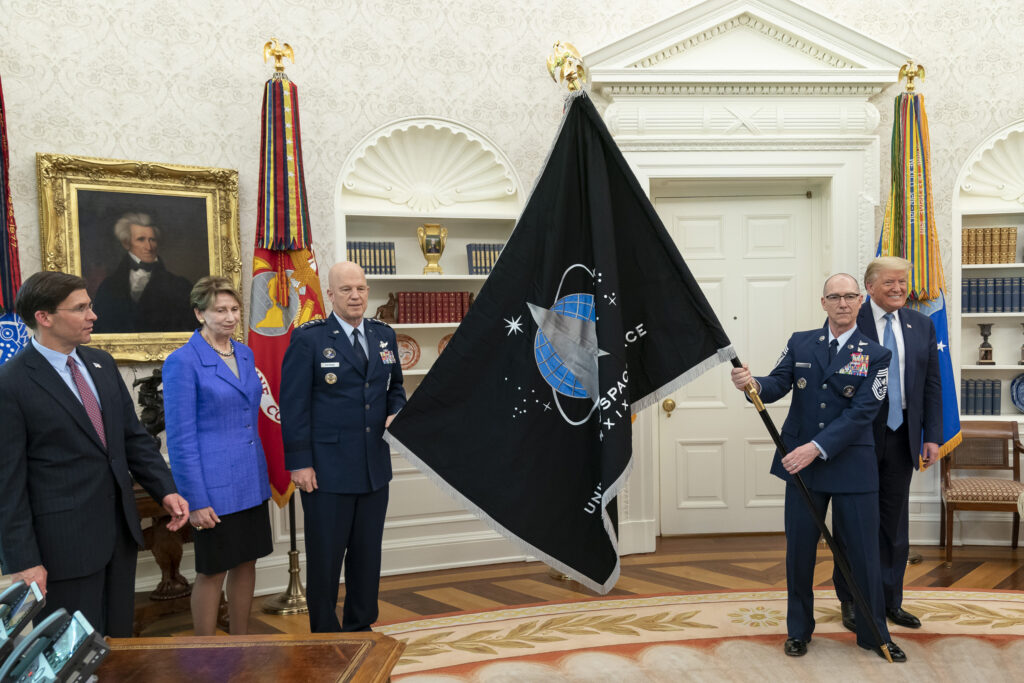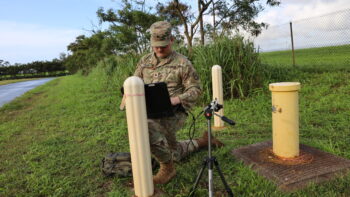 WASHINGTON: The latest version of the Air Force’s long-overdue report to Congress on space acquisition reform fails to address a number of foundational questions, critics say, including: go fast to do what; who gets to decide the what; and who is accountable if things go pear shaped?
WASHINGTON: The latest version of the Air Force’s long-overdue report to Congress on space acquisition reform fails to address a number of foundational questions, critics say, including: go fast to do what; who gets to decide the what; and who is accountable if things go pear shaped?
DoD is asking Congress to cut legislative strings and approve special powers to streamline space acquisition programs worth billions — pushing the need for speed to ensure the US military’s technical edge over China and Russia, as first reported by colleague Sandra Erwin. The proposed changes are focused mainly on ways to get the Space Force out from under current acquisition rules, both those imposed by Congress and internally by DoD regulations.
They also are “mostly a rehashed list of things that every service has asked for since time immemorial,” one national security space veteran told Breaking D, with a virtual eye roll.
Or in the words of the recently-released teaser for the upcoming Netflix comedy “Space Force”: “Your attitude seems to be: ‘Give us money and don’t look’.”
“The problem is, I think, it’s asking for a lot of trust from Congress that in space in particular hasn’t been necessarily warranted to date,” said Joshua Huminski, director of the National Security Space Program at the Center for the Study of the Presidency & Congress.
A space acquisition report, due to Congress on March 31, was delivered on May 20. Air Force acquisition head Will Roper called a press briefing last Friday to discuss it, only to abruptly cancel a couple hours later with no explanation.
A congressional aide told Breaking D on Friday afternoon that they could not release the version of the report transmitted to Congress because it was not a final version; and an Air Force spokesperson later confirmed that — well after business hours on Friday evening and before the long Memorial Day weekend).
So, it’s not really the final version. The spokesperson said: “The Department of the Air Force continues to work with DoD and interagency partners to finalize the Space Force Alternative Acquisition System report. An initial version of the report was delivered to the Hill, but we anticipate delivering the final report to Congress soon.”
As one space analyst notes wryly: “Not exactly a clean rollout.”
The nine proposed reforms are required because “current space threats demand a shift to a system that more broadly delivers agile solutions to meet an ever-evolving technical baseline and integrate into an open architecture,” according to the current report language. Three of the recommendations will require legislative changes; one will require agreement from the House and Senate Appropriations Committees.
Specifically, the nine recommendations address the following acquisition authorities for the Department of the Air Force and the Space Force:
- Unique Acquisition Category (ACAT) Thresholds, Major Defense Acquisition
Program (MDAP) Definition, and Milestone Decision Authority Delegation for Space Systems. - “Efficient Space Procurement (ESP)” Codification for the DAF/USSF.
- USSF-Unique “New Start” Notification Procedures.
- Budget Line Item Restructure.
- Modified JCIDS [Joint Capabilities Integration and Development System that sets program requirements] Approach for Space Systems.
- New Policy Regarding Key Decision Point and Reporting Requirements for Development, Fielding, and Sustainment of Space Systems.
- “Useable End Item” Determination Authority.
- Separate USSF Topline Budget.
- USSF-Unique Head of Contracting Activity (HCA).
As an example of bending the current DoD rules for the Space Force, the “Budget Line Restructure” asks Congress for authority to move money around by combining individual programs within in a large “portfolio” of similar efforts — an effort unlikely to win congressional approval, if past attempts are a guide.
Numerous critics noted it goes directly against the intent of Congress when it mandated in 2016 that DoD develop a Major Force Program to allow better tracking of both the macro military space budget and individual projects from year-to-year via a specific, standardized “program element number” in budget documentation.
Further, as Breaking D readers know, the report punts on one of the key mandates included in the 2020 National Defense Authorization Act (NDAA): to create a Space Acquisition Executive separate from the Air Force acquisition authority, a position now held by Roper.
The NDAA requires that the Air Force appoint a Senate-confirmed assistant secretary for space acquisition and integration. That person, the act said, “will “synchronize with the Air Force Service Acquisition Executive on all space system efforts, and take on Service Acquisition Executive responsibilities for space systems and programs effective on October 1, 2022.” The SAE is to oversee the Space and Missile Systems Center, the Space Rapid Capabilities Office (SpRCO), and the Space Development Agency (SDA) — all of which currently have separate acquisition authorities and lines of oversight.
Roper has fought tooth and nail against a fully separate SAE since it was proposed by Congress, according to numerous DoD sources even threatening to resign if it is created outside his purview. Sources close to the debate say that Gen. Jay Raymond, who currently is double hatted as head of the Space Force and Space Command, also does not want to see a change in the status quo that would put another layer of acquisition oversight in the mix.
Thus, the current version of the draft report simply states that Roper will hold SAE authority for now. This, several sources said, in reality is a place holder signaling that DoD intends to recommend in future that Congress essentially ditch the idea.
“We want to ignore your direction on the separate SAE [Space Acquisition Executive] – thanks, but we know better,” the former national security space official summed up. “And it ain’t a signal – it’s a shot across the bow.”
“On face value, I think it does seem to suggest they are trying to avoid the separate Space Acquisition Executive, which when combined with the bucketing of money is unlikely to be well received by Congress,” Huminski said.
“Congress is going to want some balance here, at least I think,” he added. “If the Space Force wants the authority to move money around within the portfolios, they are going to need to provide some measure of confidence to Congress that it is being done in an efficient and transparent manner, which could be the SAE—at least someone accountable for those money moves.”
Failure to restructure the space acquisition organization, critics point out, leaves open the critical question of how DoD plans to fix the problem of lack of coordination with the Army and Navy on user equipment, for which they have acquisition authority. (We’re looking at you, GPS III.) While the Space Force in the near term will comprise only Air Force personnel either seconded or transferred, the expectation is that eventually it will include Army and Navy personnel as well.
A number of critics further charge that the requested changes do not sufficiently address the fact that previous space program cost overruns and schedule delays can be attributed to lack of coherent, coordinated and disciplined management at the program level within Space and Missile Systems Center itself, not due to outside factors.
“All of the changes they’ve asked for are external to the Space Force,” said one former DoD official, rather than taking a hard look at past program management. “Instead it’s: ‘Congress has to change; Ellen Lord [DoD acquisition czar] has to change; the JROC [Joint Requirements Oversight Council] has to change.”
“The answer isn’t ‘we’ve just gotta go fast’,” the official added.
“One of the biggest challenges is the proverbial acquisitions rubber meeting the road—unless the Space Force changes what they are buying, changing how they buy it may not matter,” Huminski explained. “If the same architectures and same vehicles and same capabilities are bought, just faster, what was the point of changing anything at all?”
DoD sources defend the proposal, saying that Congress asked for, and expected to receive, ‘bold recommendations’ on how to change the current space acquisition system.
Noting that there are many conflicting pressures, one DoD source said that concerns about transparency and who does what exactly have been overtaken by concerns that the Space Force “be empowered to go fast, innovate, and achieve the space dominance wanted by POTUS.”
Another government official keeping tabs on the issue said sympathetically that in some ways, “they are damned if they do, and damned if they don’t.” While some in Congress likely will be annoyed by the recommendations push to get out from under current regulations, the source said, others would have complained loudly if DoD failed to move from the status quo.
Spokespeople for a number of key House and Senate members involved in defense oversight did not respond to requests for comment.
However, DoD sources and several analysts with close Hill ties said Congress is most likely to be concerned by the recommendations that infringe upon Congress’s own powers. For example, members of the House and Senate Armed Services Committees are almost certain to protest the recommendation that assumes approval if Congress doesn’t respond to “New Start” notifications within 30 days.
Israel signs $583 million deal to sell Barak air defense to Slovakia
The agreement marks the latest air defense export by Israel to Europe, despite its ongoing war in Gaza.
























